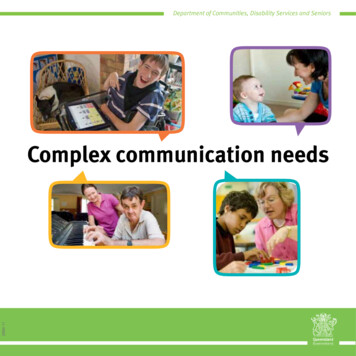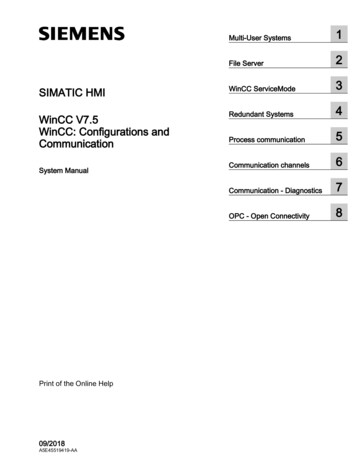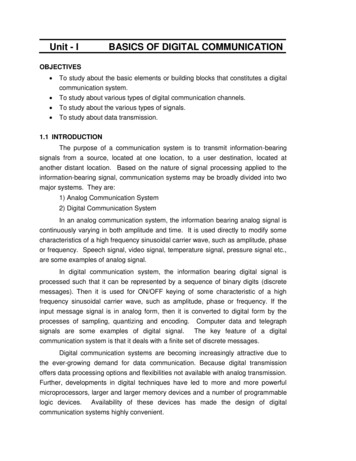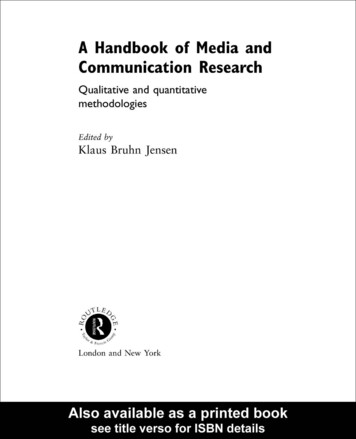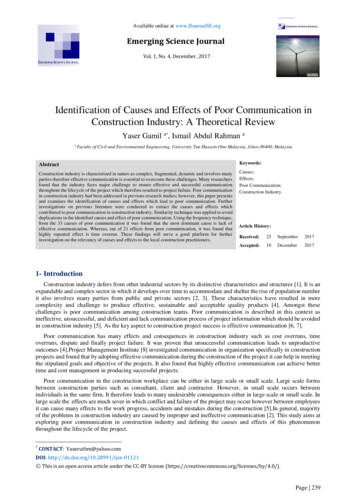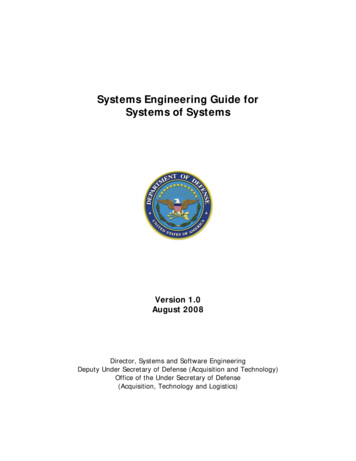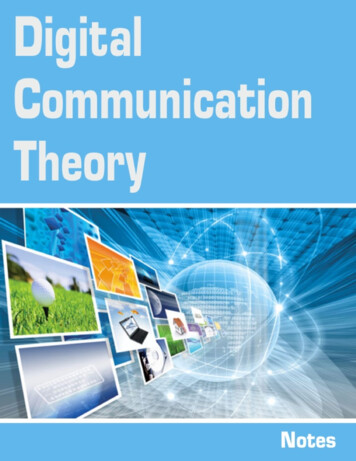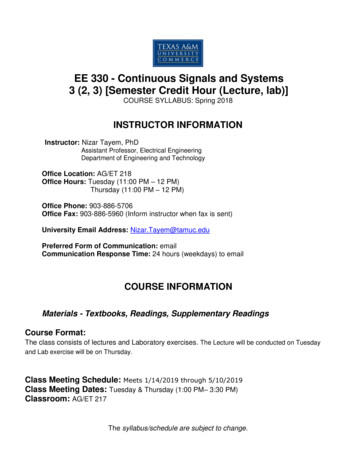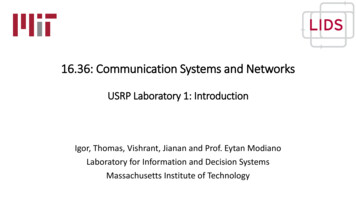
Transcription
16.36: Communication Systems and NetworksUSRP Laboratory 1: IntroductionIgor, Thomas, Vishrant, Jianan and Prof. Eytan ModianoLaboratory for Information and Decision SystemsMassachusetts Institute of Technology
Outline Goal familiarity with LabVIEW Communications and with the USRP introduce the concept of modulation Intro to LabVIEW Communications experiment one: Hello World experiment two: PAM-2 and Power Spectrum Density Intro to the USRP experiment three: Send and receive a tone signalObs.: A few questions will be made during the lab.Each pair of students should turn in the answers!2
Intro to LabVIEW Communications LabVIEW Graphical Programming Environment LabVIEW Program Virtual Instrument (VI) Front PANEL User Interface Block DIAGRAM Graphical Code Software in your workstation: LabVIEWLabVIEW CommunicationsDrivers to the USRPMATLAB3
Experiment ONE: Hello World Big Picture: read an input string and copy it to an output stringString InputString OutputFront PanelHelloWorldHelloWorldBlock DiagramStringInputStringOutputLaboratory script ( 10 minutes). Wait for instructions on Experiment TWO.4
Experiment TWO: PAM-2 and PSD Big Picture: transform a bit sequence into a baseband signalGenerationof bitsPAM-2BasebandSignalBITSSYMBOLSBASEBAND SIGNALPSDA101time1 -1 1T2T3T-A5
Experiment TWO: PAM-2 and PSD Big Picture: transform a bit sequence into a baseband signalGenerationof bitsPAM-2BasebandSignalPSD Question: how to transform a sequence of bits into a sequence of symbols using PAM-2? Example: 11101000111001 into PAM-2?Answer: 1 1 1 -1 1 -1 -1 -1 1 1 1 -1 -1 16
Experiment TWO: PAM-2 and PSD Big Picture:Generationof bitsPAM-2BasebandSignalPSD Question: how to transform a sequence of symbols into a baseband signal? Example: 1 1 1 -1 1 -1 -1 -1 1 1 1 -1 -1 1 into a sequence of rectangular pulses?(more specifically )7
Experiment TWO: PAM-2 and PSDSequence of symbols1 -1 1PAM-2Hint:BasebandSignal?Baseband SignalPulse ShapeAAtimeTtimeT-A2T3T
Experiment TWO: PAM-2 and PSDSequence of symbols1 -1 1PAM-2 Pre-processingBasebandSignal ConvolutionBaseband SignalPulse ShapeAAtimeTtimeT-A2T3T
Experiment TWO: PAM-2 and PSDSequence of symbols1 -1 1PAM-2Pre-processingProcessedSymbolPulse Shape1ATTtime-12Ttime10
Experiment TWO: PAM-2 and PSDSequence of symbols1 -1 1PAM-2Pre-processing?ConvolutionSymbolPulse Shape1ATTtime-12Ttime11
Experiment TWO: PAM-2 and PSDSequence of symbols1 -1 and SignalPulse ShapeAAtimeTtimeT-A2T3T12
Experiment TWO: PAM-2 and PSD [Discrete Case]Sequence of symbolsAdding K-1 zeros after each symbol1 -1 1PAM-2Upsamplingwith K(for K 3)ConvolutionBasebandSignalBaseband SignalPulse Shape113 4 51 2samples-11 26 7 8samples13
Experiment TWO: PAM-2 and PSD Big Picture:Generationof bitsPAM-2BasebandSignalPSD PSD: Power Spectrum Density of the Baseband Signal:𝑃 𝑓𝑘 𝑋 𝑓𝑘2,where 𝑋 𝑓𝑘 is the Fourier transform of the baseband signal14
Experiment TWO: PAM-2 and PSD Big Picture:Generationof bitsPAM-2BasebandSignalPSD Experiment TWO: Goal: implement the system above. Please follow the instructions on your laboratory script. ( 30 minutes) Stop after finishing. Wait for instructions on Experiment THREE.15
Experiment THREE: Radio Software Defined Radio: some components that have been typically implemented inHW are implemented by means of SW HW Characteristics:USRP 2900Frequency range 70 MHz to 6 GHzFrequency step 1kHz56 MHz bandwidthMaximum output power (Pout) 20 dBmTri-band antennas: 144MHz, 400MHz, 1200MHz Electrostatic Sensitive DevicesBased on the book “Introduction to Communication Systems”, by Bruce A. Black.16
Experiment THREE: Radio LabVIEW interacts with the USRP TRANSMITTER by means of four blocks:17
Experiment THREE: Radio LabVIEW interacts with the USRP transmitter by means of four blocks:Open Tx Session: initiates the transmitter session control “device names” to informLabVIEW of the USRP ID.18
Experiment THREE: Radio LabVIEW interacts with the USRP transmitter by means of four blocks:Configure Signal: is used to set IQ rate 1/𝑇 Carrier Frequency 𝑓𝐶 Gain 𝐴 Active Antenna19
Experiment THREE: Radio LabVIEW interacts with the USRP transmitter by means of four blocks:Write Tx Data: Sends the baseband signal to the USRPfor transmission. Baseband signal array of complexvalues.If we write: 𝑔𝐼 𝑛𝑇 𝑗𝑔𝑄 (𝑛𝑇)The transmitted signal is: 𝐴𝑔𝐼 𝑡 cos 2𝜋𝑓𝑐 𝑡 𝐴𝑔𝑄 𝑡 sin 2𝜋𝑓𝑐 𝑡20
Experiment THREE: Radio LabVIEW interacts with the USRP transmitter by means of four blocks:Close Session: Terminates transmitter operation.21
Experiment THREE: Radio LabVIEW interacts with the USRP RECEIVER by means of five blocks.22
Experiment THREE: Radio LabVIEW interacts with the USRP receiver by means of five blocks. Most blocks are analogous. The main difference is:Fetch Rx Data: Receives block of samples from theUSRP. The size of the block is controlled bythe parameter “number of samples” Samples are provided as an array ofcomplex numbers.23
Experiment THREE: Radio Big Picture:Power Attenuator.Used to avoid burningthe radio. Experiment THREE: Goal: transmit a tone signal using cables and antennas. Compare the results.Please follow the instructions on your laboratory script.Turn in your answers at the end of the lab!Frequency assignments next.24
Frequency assignment Unlicensed Band: from 902 MHz to 928 MHz 5 groups each has 5.2 MHz of available BW Central Frequency Assignments: S1 Radio1 TX: 904.6 MHzS2 Radio1 TX: 909.8 MHzS3 Radio1 TX: 915 MHzS4 Radio1 TX : 920.2 MHzS5 Radio1 TX : 925.4 MHz25
Supplementary Slides26
Experiment THREE: Radio Big Picture:Power Attenuator.Used to avoid burningthe radio. Experiment THREE: Goal: transmit a tone signal using cables and antennas. Compare the results. Please follow the instructions on your laboratory script. Turn in your answers at the end of the lab!27
Experiment TWO: PAM-2 and PSD Raised Cosine:Frequency ResponsePictures by KrishnavedalaTime Response28
Experiment TWO: PAM-2 and PSD Raised Cosine:Frequency Response: (Squared) Root-Raised Cosine:Frequency Response:𝐻𝑟𝑟𝑐 𝑓 𝐻(𝑓) Look into Nyquist ISI Criterion29
USRP 2900 ased on the book Introduction to ommunication Systems _, by ruce A. lack. Experiment THREE: Radio 17 LabVIEW interacts with the USRP TRANSMITTER by means of four blocks: Experiment THREE: Radio 18 LabVIEW interacts with the USRP transmitter by means of four blocks:

